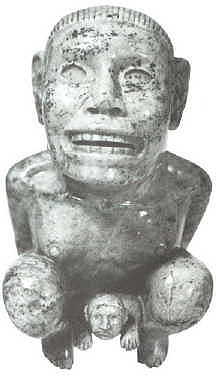(IE entries in parentheses are keywords in Pokorny 1959)
entries marked by ** have been reconstructed by the author
[S = Sumerian; ES = Emesal dialect; B
= Basque;
IE =
Indo-European; E = Egyptian; A =
Arabic;
numbers after Sumerian entries are
sign or combination-sign numbers in Jaritz 1967;
numbers after Basque entries are
entry numbers in the PL-IE-Basque essay at this
website]
x after a Sumerian entry indicates a reading for a
sign by the author which has
not (yet) been acknowledged by Sumerologists; and, as a consequence, has no official number
assigned
|

ANALYSIS OF
SUMERIAN SENTENCES
To illustrate the principles which have been explained in the
four accompanying essays, some translations from Sumerian
with links to the sections which explain the rationale of the translations will now be presented.
1. ab.ba-ab.ba gu2.tuku-gin7 bur.šu.ma-e-ne gaba.ud.da-zu A.HAR ud ul.li2-a-aš ši-im-dug3-dug3-ge-ne (Lugalbanda in Hurrumkura 245-247 in Claus Wilcke, Das Lugalbandepos, Wiesbaden 1969:82)
this is the translation that has been offered:
Like all(?) the first old men, the old women enjoy your sunshine until distant days.
GENERAL CRITIQUE:
a. gu2.tuku is apparently interpreted as "take (the) front", therefore, "(come) first". But this is not an attempt to describe ancient society! ab.ba also means 'tower, barge-puller'; and gu2 also means 'riverbank', the natural place to find a 'barge-puller'. The offered translation totally ignores (A..)HAR, which we emend to (-a )ur(a)5, and translate as '-at mill(-stone)', and ignores the parallelism between the 'towers' at the 'river-bank' and the bur-šu-ma(-e-ne) urâ5 'at the mill' (ura5 + -a).
b. bur-šu-ma-ta does have an Akkadian gloss purš[umtu], which has been interpreted as 'gray, old person', but what we have in the passage is bur-šu-ma(-e-ne), which means 'temple-official(s)'. One of the meanings of bur is '(stone-)vessel'; and ma-ma has the Akkadian gloss kalû, which probably means '*fill (up)'. The parallelism with the 'towers' suggests strongly that the correct interpretation of bur-šu-ma should be analyzed as bur, 'jar'; šu, 'hand'; and ma, '*fill', i.e. 'jar-fillers', presumably with flour since they are located at the mill, which may well have been a duty of the elderly; the parallel is, therefore, between professions or activities not between old men and old women.
c. gaba-ud.da has the offered translation of 'sun(-)shine', apparently based on a meaning of the sign of 'glow, burn', usually associated with the reading du8 of this sign. However, gaba also means 'breast, front' as well as 'open, split'; and the likelier interpretation is that it is an adverbial phrase that links the 'enjoyment' of the 'towers' and 'jar-fillers' to a particular time of day, namely 'day-break'.
d. zu has the offered translation of 'your'. But this is not a hymn to the sun-disk ('your sunshine') only a simple description of one of the commonalities of ordinary life. It is better to translate zu as 'inform(ation)'. We connect the following A(.) with zu, producing zu.a, 'what is known = information (news)'.
Therefore the sentence should be re-written as:
ab.ba-ab.ba gu2.tûkU-gin7 pur(yu)x.šu.ma-e-ne kap(a)2.ud.da zÛ.a harâ ud ul.lê21-a-aš ši-im-dük(a)3-dük(a)3-kê2-nê
and translated as:
So, like all the towers who have the river-bank, at daybreak, the jar-fillers will be thoroughly enjoying the news there at the mill until days which are faraway.
2. ensi2-ensi2 sa(n)g[~]3a-e-ne sa12.du5 Gu2.eden-na-ke4-ne nidba itud-da zag.mu-bi-im si am3-ma-sa2-e-ne (Curse of Akkade 51-53 in Adam Falkenstein, Fluch über Akkade, Zeitschrift für Assyriologie und Vorderasiatische Archaeologie 57:61ff., Berlin)
this is the translation that has been offered:
All the ensi's, the sanga's, and the record-keepers of Guedena prepared the offerings for the new moon and new year ceremony.
GENERAL CRITIQUE:
a. gu2.tuku is apparently interpreted as "take (the) front", therefore,
b.
Therefore the sentence should be re-written as:
ênsi2-ênsi2 sa(n)k2a-e-ne sa12.du5 Gu2.eden-na-kê4-nê nidba itud-da zag.mu-bî-îm(â) si am3-ma-sê/î8-ê-nê
and translated as:
All the ensi's, the sanga's, and the record-keepers(?) of Pasture's Edge were immediately preparing there offerings of the month that is their new year.
(continued in Part Six)

continue to
Sumerian
Grammar (Part Six)


PL MORPHOLOGICAL ELEMENTS IN
SUMERIAN
(not included under lexical headings)
press to see
For an INDEX (by
entry number) of the Proto-Language, Indo-European, and Sumerian words
discussed in these essays, press here.
to investigate these phonological correspondences in detail, see
the
TABLE OF PL / IE / SUMERIAN
CORRESPONDENCES
NOTATIONAL CONVENTIONS
For an explanation of the Proto-Language and Indo-European notational
conventions used in these essays, press here.
Combinatory Modifications
for modifications of the vowels and consonants in combination, see
the
Summary of Phonological Changes
PROTO-LANGUAGE MONOSYLLABLES
In order for readers to judge the semantic plausibility of the analysis of
Proto-Language (PL) compounds suggested here, I
am including access to a table of
Proto-Language monosyllables and the meanings I have
provisionally assigned.
Most assignments can be exhaustively supported by data from actually attested forms but a
few animates are very doubtful; and this list does not represent the "final" solution of these
questions, which will only be approached when other scholars assist in refining it.
Patrick C. Ryan
Summer 1998
SUMERIAN
BIBLIOGRAPHY
ADDITIONAL BIBLIOGRAPHY

the latest revision of this document can be found at
HTTP://WWW.GEOCITIES.COM/Athens/Forum/2803/SumerianGrammar-5.htm

Patrick C. Ryan * 9115 West 34th Street - Little Rock, AR
72204-4441 * (501)227-9947
PROTO-LANGUAGE@email.msn.com
NOTES
1. Seen in Indo-European *o/o:li, '*distant (in time)', in Old Latin olitana, 'antiquity', listed under *1. al-, 'above and beyond (Proto-Language HO-N[H]A-¿E, 'pounce-move-ing = jumping over = going beyond').

 (7/24/99)
(7/24/99)



 (7/24/99)
(7/24/99)



![]()
